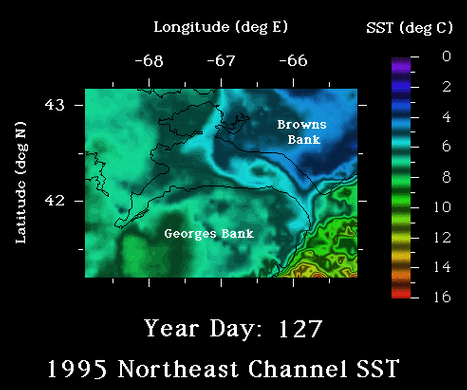Cross-Frontal Exchange and Scotian Shelf Cross-over Workshops
10-12 October, 2000
Holiday Inn, Falmouth, Massachusetts
|
Cross-Frontal Exchange and Scotian Shelf Cross-over Workshops 10-12 October, 2000 Holiday Inn, Falmouth, Massachusetts |
|
Overview
Cross-Frontal Exchange
Presentations
|
Seasonal SST Frontal Climatologies on Georges Bank Jim Bisagni (SMAST) 1) Literature/historical data show < 32.0 PSU surface waters on eastern Georges Bank (GB) and southern flank of GB during late winter-spring. Moreover, Sea Surface Temperature (SST) frontal probability climatologies show evidence of cross overs during the months of January through March (Figs E1, E2 below).  Source
waters from the western Scotian Shelf cross Northeast Channel. Source
waters from the western Scotian Shelf cross Northeast Channel.  Must have important
chemical and biological implications for GB.
Must have important
chemical and biological implications for GB.
2) There appears to be large interannual variability in magnitude of Scotian Shelf Water (SSW) cross-over events.  Satellite-derived
SST and in-situ hydrographic data from winter-spring 1992 displayed a large SSW
cross-over, while similar data from winter-spring 1993 showed a much-reduced
cross-over. Satellite-derived
SST and in-situ hydrographic data from winter-spring 1992 displayed a large SSW
cross-over, while similar data from winter-spring 1993 showed a much-reduced
cross-over.  Interannual
variability of SSW cross-over magnitude (1992 vs. 1993) appears related to
volume discharge of St. Lawrence River 9-months earlier (~April), other years
display no such relationship. Interannual
variability of SSW cross-over magnitude (1992 vs. 1993) appears related to
volume discharge of St. Lawrence River 9-months earlier (~April), other years
display no such relationship.  Velocity and
transport estimates of SSW onto GB during the winter-spring 1992 event using a
slab mixed-layer model and along-Bank heat budget are 13.4 cm s-1
and 0.21 Sv, respectively. (Bisagni et
al., 1996) Velocity and
transport estimates of SSW onto GB during the winter-spring 1992 event using a
slab mixed-layer model and along-Bank heat budget are 13.4 cm s-1
and 0.21 Sv, respectively. (Bisagni et
al., 1996)  Using a
low-salinity anomaly criterion, the maximum frequency of low salinity anomalies
occurs during February and June at 0 and 20-m depth on the Northeast Peak of
GB. (Bisagni & Smith, 1998)
Using a
low-salinity anomaly criterion, the maximum frequency of low salinity anomalies
occurs during February and June at 0 and 20-m depth on the Northeast Peak of
GB. (Bisagni & Smith, 1998) 3) Dynamical mechanism(s) causing the SSW cross-over is elusive.  Preliminary
modeling indicates that a purely barotropic current cannot break the constraint
of steep bottom topography across Northeast Channel. (Williams, 1995) Preliminary
modeling indicates that a purely barotropic current cannot break the constraint
of steep bottom topography across Northeast Channel. (Williams, 1995)  Satellite-derived
SST and in-situ observations from April-May 1995 show that a long-lived,
elliptical cyclone moving through Northeast Channel, possibly due to
wind-driven effects, may have caused the SSW cross-overs. (Fig E3, below) (Bisagni &
Smith, 1998) Satellite-derived
SST and in-situ observations from April-May 1995 show that a long-lived,
elliptical cyclone moving through Northeast Channel, possibly due to
wind-driven effects, may have caused the SSW cross-overs. (Fig E3, below) (Bisagni &
Smith, 1998) References: Bisagni, J.J. and M.H. Sano. 1993. Satellite observations of short time scale sea surface temperature variability on southern Georges Bank. Cont. Shelf Res., 13, 1045-1064. Bisagni, J.J., R.C. Beardsley, C.M. Ruhsam, J.P. Manning, and W. Williams. 1996. Historical and recent evidence concerning the presence of Scotian Shelf water on southern Georges Bank. Deep-Sea Res., 43, 1439-1471. Bisagni, J.J., and P.C. Smith. 1998. Eddy-induced flow of Scotian Shelf water across Northeast Channel, Gulf of Maine. Cont. Shelf Res.,18, 515-539. Williams, W.J. 1995. The adjustment of barotropic currents at the shelf break to a sharp bend in the shelf topography. M.S. Thesis, MIT/WHOI Joint Program, Cambridge, MA. 
Figure E1. Climatological SST frontal probability for the month of January (1985-96) 
Figure E2. Climatological SST frontal probability for the month of March (1985-96) 
Figure E3. SST evidence for Scotian Shelf cross-over induced by a cyclonic eddy in Northeast Channel. |